A few years ago, AI was a rare technology used by a few teams across each field. Machine learning adoption was celebrated but not required. In 2024, this is no longer the case. Most platforms see AI as part of their core feature set, and users expect some kind of machine learning assistance across most industries.
With generative AI and other machine learning advancements, not leveraging deep learning and other technologies would mean becoming an outlier in an increasingly AI-enhanced world.
Key points of the article
- Specifics of the AI engineering job function
- AI team structure
- Different approaches to hiring an AI developer
- Hiring process for AI developers
Why do teams hire AI developers?
Seeing how artificial intelligence helped offset recession fears created a sense of urgency among business leaders and investors. Indeed, machine learning can help add millions in value to most industries, but tapping into the market requires a specialized team.
While experienced software architects can transition into AI engineering and cover the machine learning needs of your organization, having an expert on board with an excellent command of specific AI tools and technologies increases the odds of success for the product.
Here are the AI engineer responsibilities that drive progress in product teams:
- Guide product design to ensure that AI (artificial intelligence) helps reach business goals and deliver value to end-users.
- Manage research and development efforts to determine which AI (artificial intelligence) tools and technologies would
- Offer the most accurate and cost-effective solutions to a specific problem.
- Navigate the regulatory landscape, monitor potential challenges in deploying AI models, and design workarounds.
- Explain the impact of AI/ML technologies to non-technical teams and help them leverage the use of machine learning.
Is it difficult to hire an artificial intelligence engineer?
In the last two years, tech companies have become increasingly aware of the importance of leveraging AI. With that came a sense of urgency and pressure to build an internal artificial intelligence department.
As a result, demand for AI talent has grown exponentially while supply is failing to catch up. To understand the magnitude of the talent shortage, we examined relevant data points from global sources.
- Across OECD countries, 0.34% of employees have AI skills. (OECD)
- Four most hired roles at companies are AI software developers, instrumental in building new solutions: AI researchers who study new AI algorithms and systems; software developers responsible for the code supporting AI systems; and data scientists who extract insights from information. (Deloitte)
- Engineering leaders struggle to find experts for product design (48%) and data science (36%). (The Engineer)
- 73% of organizations focusing on engineering, research, and development (ER&D) companies report talent gaps. The divide is estimated to become more pronounced as baby boomers retire faster than new graduates enter the job market. (Bain and Company)
This data shows that hiring engineering talent is a global challenge for product teams.
In startup hubs — Silicon Valley, Boston, NYC in the US, or London, Paris, and Berlin in Europe — finding a skilled and affordable engineer is a struggle due to the many high-profile offers and a high AI developer salary.
AI Engineering team structure
According to Gartner, the lack of a well-structured AI engineering department leaves 50% of AI projects at the proof-of-concept stage. Building a balanced team is vital to avoid stagnation and push the project ahead.
Xenoss executives have over 15 years of experience in building high-performing AI teams. A consistent finding that emerged over time was that no two teams were alike in terms of roles to prioritize. Depending on the scale of the project (internal tool, narrowly specialized user-facing tool, or multi-purpose large-scale platform), the list of people who should steer the project varies, and the emphasis on ethics and regulations can sometimes be more pronounced.
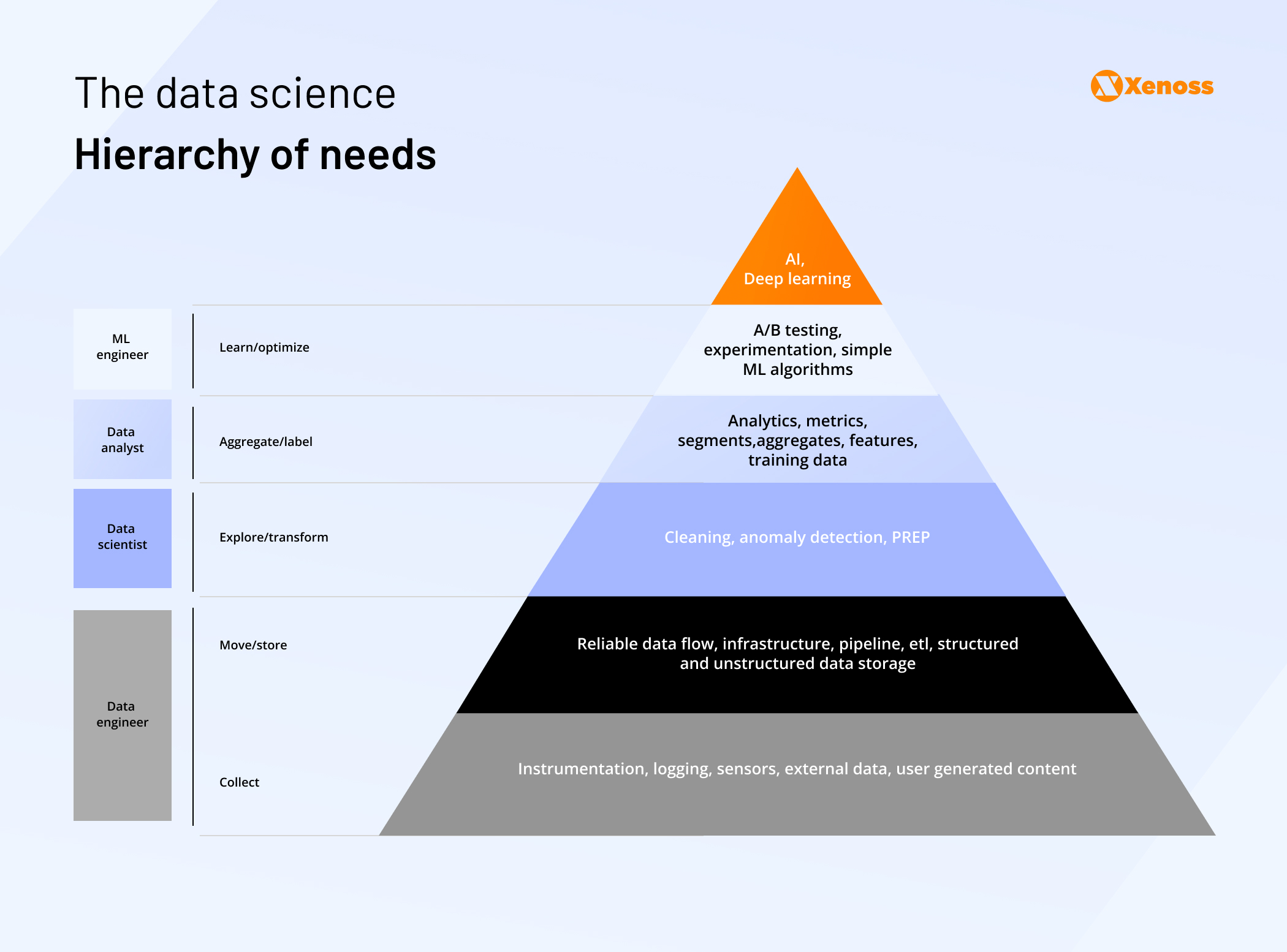
Every step of data collection, processing, and deployment as part of an ML model aligns with a specific role:
Data engineer responsibilities
- Builds and tests ETL pipelines
- Architects SQL and NoSQL data stores
- Builds strategies for data processing, integration, transformation, and storage
- Oversees AWS/Google Cloud/Microsoft Azure maintenance
- Collects, cleans, and filters structured and unstructured data
Data scientist responsibilities
- Aligns with business stakeholders on high-priority problems
- Collaborates with data engineers
- Tests machine learning models
- Supports other teams (sales, marketing, product) with data needed for strategic decision-making
Data analyst responsibilities
- Applies large data sets to solving business problems through a range of analytical and statistical tools
- Helps identify success metrics in product teams, build growth projections, and monitor the progress across selected metrics
- Uses data to identify emerging trends and opportunities that help steer the product
- Closely partners with Engineering, Product, Marketing, and other teams to inform their reasoning
AI developer (ML engineer) responsibilities:
- Deploying, maintaining, and scaling machine learning models
- Engineering of the infrastructure surrounding machine learning models
- Platform engineering and MLOps: developing and administering Kubernetes clusters
- Security scanning and investigations
- Release engineering
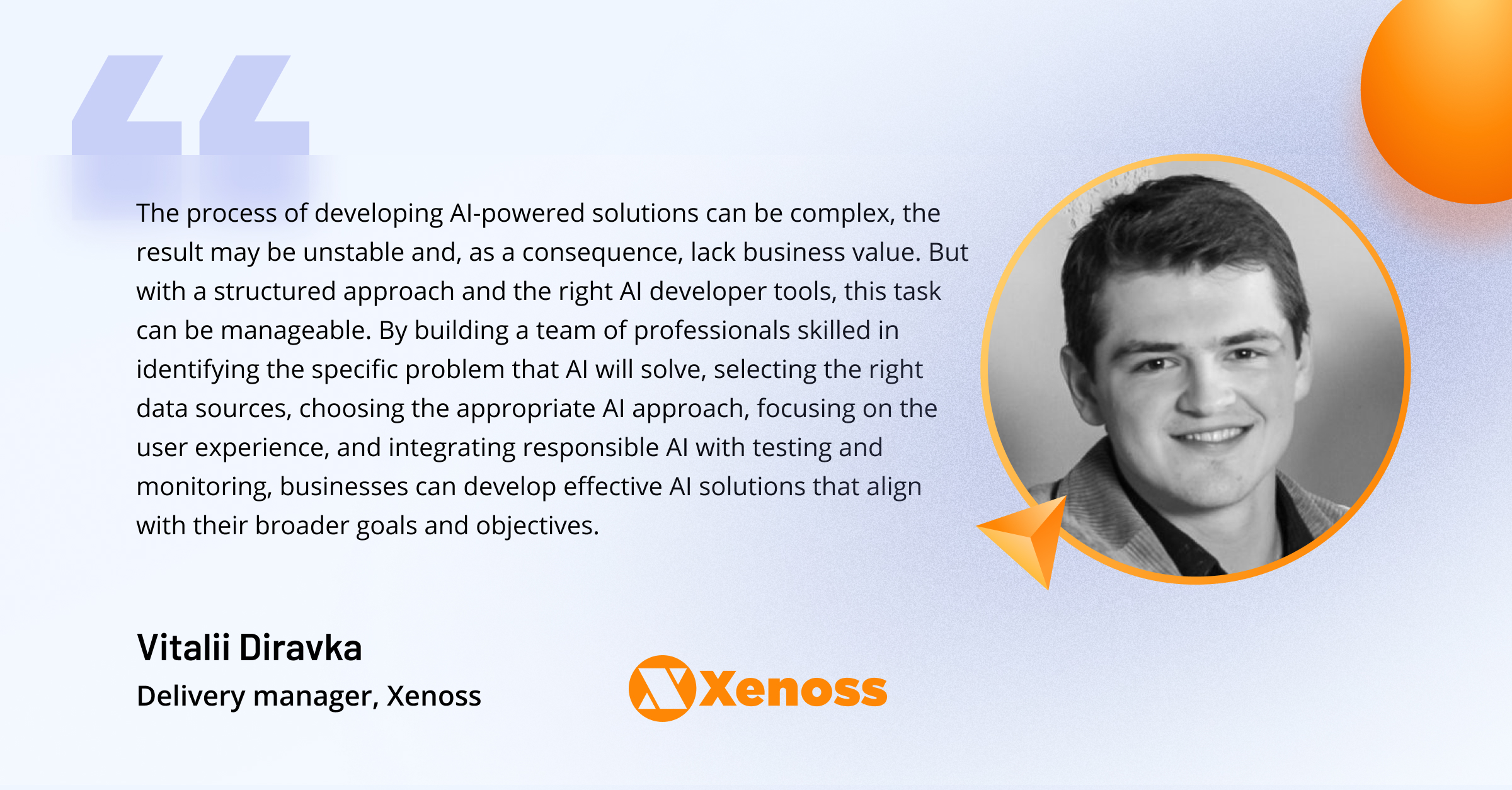
These are the roles directly involved in building AI models. Other professionals typically support these functions:
- Project manager responsible for overseeing the project lifecycle: defining project scope, goals, timeline, budget, etc.
- Domain expert: a professional who provides domain expertise and context for machine learning models. In some cases, this role can be carried out by AI engineers themselves if they are well-versed in the field of the project.
- Systems Architect helps build a suite of machine learning tools within the organization’s IT framework, ensuring alignment between ML (machine learning) initiatives and broader organizational goals.
- AI data analyst specializes in using artificial intelligence tools and techniques to analyze complex datasets. This role requires a deep understanding of machine learning, data mining, and statistical analysis to extract meaningful insights and inform business strategies.
- AI architect: responsible for building an enterprise-wide AI pipeline for the organization. These professionals also play a role in connecting other members of the engineering team: data scientists, DevOps, MLOps, and business leaders.
- AI product manager: oversees the development and implementation of AI-based products, balancing technical feasibility with market needs and user experience. This role involves strategic planning, cross-functional collaboration, and a deep understanding of AI (artificial intelligence) technologies to guide the product lifecycle from conception to launch
We’d like to point out that a cookie-cutter approach is typically ineffective when assembling an AI engineering team. Instead, it’s better to look for tech professionals with specialized skill sets that match AI technologies and the types of tools the product team has in mind.
Here’s an example of how the critical skills of AI engineers on a team can vary depending on the type of the final product.
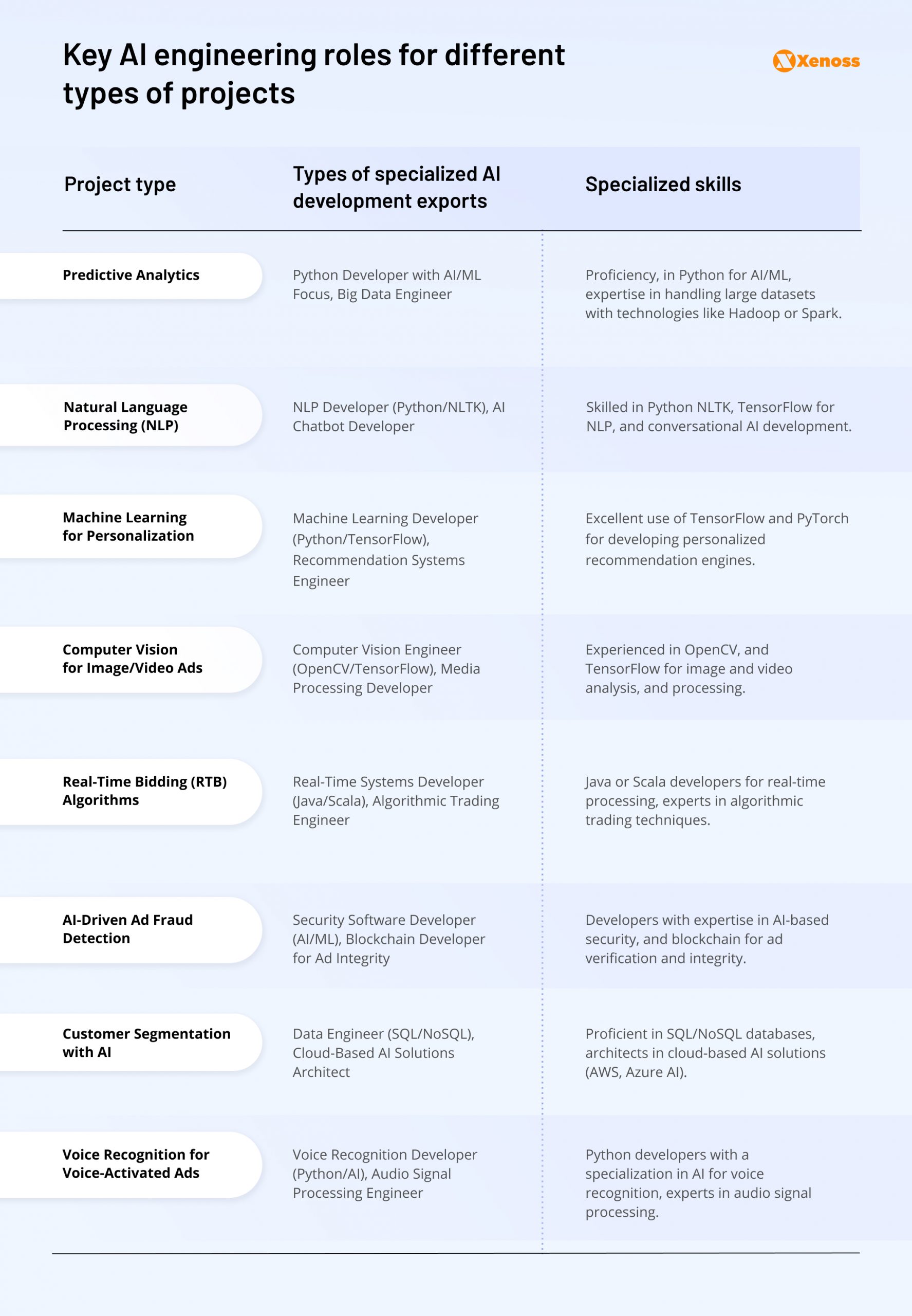
AI developer job description examples from OpenAI and other companies
After defining which AI engineering roles can enable fast and efficient product development, product team leaders should focus on finding professionals whose skills match their responsibilities.
Rather than relying on a one-size-fits-all approach, we recommend crafting a custom job opening based on your domain, type of product, budget, and expected responsibilities for each AI (artificial intelligence) role.
However, having a clear understanding of what top AdTech companies are listing in AI developer openings can help align expectations with the reality of current AI development tools and technologies.
To help engineering team leaders create job descriptions that attract skilled talent, we analyzed how top AI (artificial intelligence) players craft job descriptions for a range of roles.
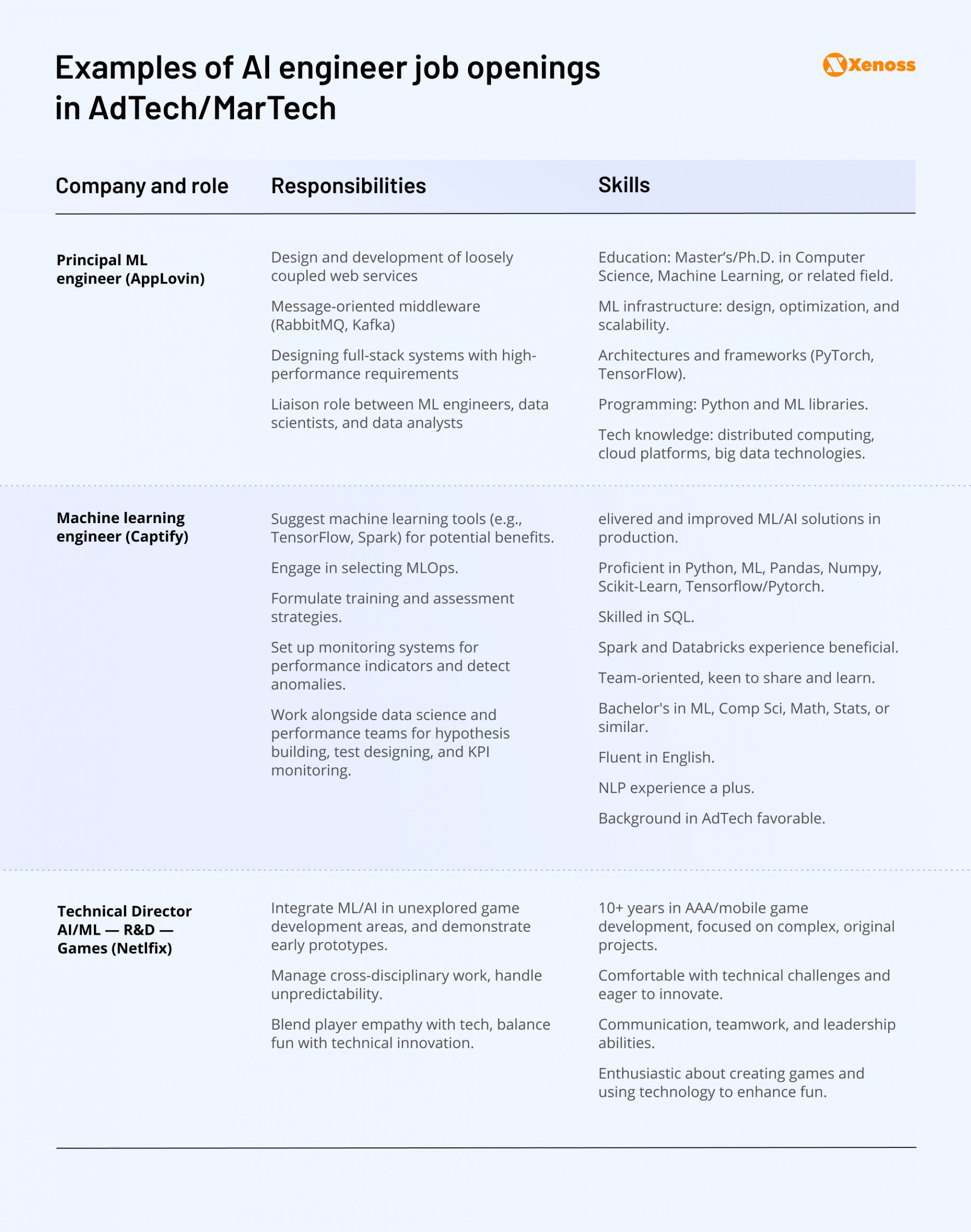
Three widely used approaches used to hire artificial intelligence developers
The tight AI engineering job market calls for open-mindedness and creativity in hiring decisions. Hiring a full-time in-house engineering team has been the industry standard for a long time, but difficulties in securing talent and a fluctuating economy are challenging that practice.
Alternative approaches to hiring, like relying on contractors or committing to outstaffing, are gradually becoming more widespread among AI (artificial intelligence) development companies.
Let’s examine their strengths and shortcomings to draw a line between these ML developer hiring strategies.
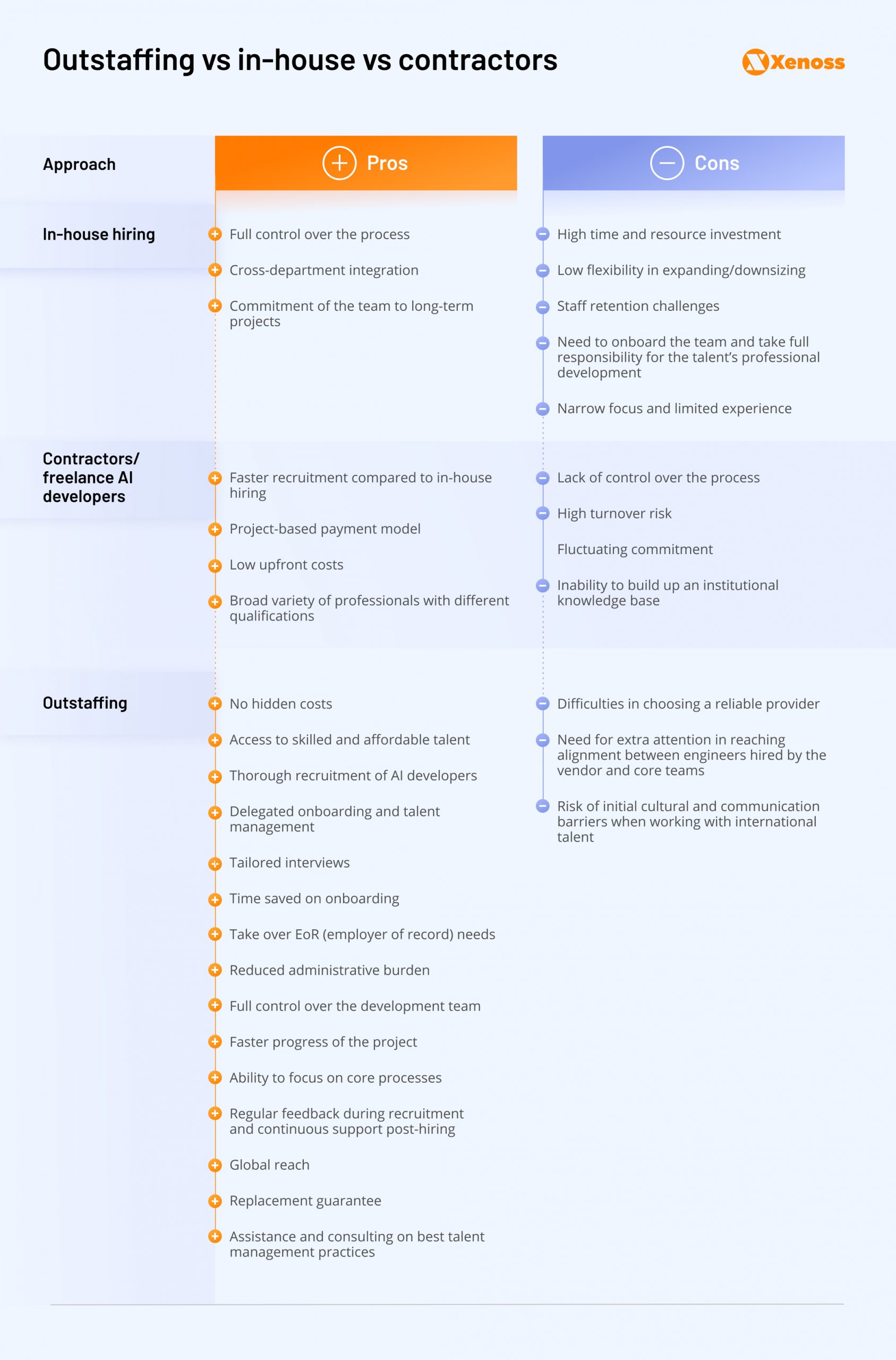
There are different ways to use outstaffing to hire AI engineers. For example, tech teams can use the model for point-based hiring (e.g., hiring single AI engineers to strengthen existing teams) or building entire AI teams from scratch.
Look at the projects where Xenoss recruiters helped source AI engineers and related specialists: data scientists, analysts, and other professionals.
How we work at Xenoss
Xenoss has supported teams in machine learning and AI adoption for over 15 years. When approached by a new project, we focus on building a team with a deep understanding of our primary domains — MarTech/ AdTech and Media — and a robust range of machine learning tools and technologies. Through a series of technical interviews and culture fit assessments, we ensure that Xenoss AI engineers are a tight fit for the client’s project.
Xenoss has a robust pool of vetted and battle-tested AI engineers. If one of our developers meets the project’s needs, we introduce the developer to the core team and schedule a technical interview. This approach allows us to cut hiring time and recruit skilled AI engineers in a matter of days.
If no AI engineers in our talent pool meet the client’s need, Xenoss hiring experts will source skilled candidates by sharing curated job openings in trusted tech communities.
Building a winning AI (artificial intelligence) engineering team with Xenoss typically looks as follows:
Discovery call
Our engineering team assesses your project proposal to see what type of AI expertise is necessary. A deep assessment of the product plan and roadmap allows Xenoss recruiting experts to hire skilled engineers and build the solution at minimal time-to-market.
CV screening and preliminary assessment
Based on the client’s requirements, Xenoss recruiting experts create detailed job descriptions that give developers a clear idea of their responsibilities and required skills.
The candidates for each application are screened to match the following criteria:
- Proven track record in the relevant field
- Proficiency in using machine learning tools and frameworks (PyTorch, Scikit, NumPy, TensorFlow, etc.)
- Domain knowledge in AdTech and MarTech
- English fluency
- Additional project-specific criteria
Vetting of shortlisted candidates
All candidates, skilled enough to move to the interview stage, are thoroughly vetted by our HR department to make sure that their experience, education profile, and other data are legitimate.
Here are the steps of our vetting process:
- Contact the companies candidates worked at previously
- Confirm education and other credentials
- Validate the recommendations provided by the applicant
- Check publicly available social media profiles and other data sources
Interviews
To confirm that an AI engineering candidate is a tight fit for the project, Xenoss recruiting team has developed a battle-tested approach to interviewing applicants. We use a three-step process to gauge a candidate’s knowledge:
- The HR department conducts a culture fit interview to align expectations and see if the candidate matches the company’s culture.
- Deep technical interviews with questions relevant to the candidate’s prior experience and the ability to apply skills used in prior projects (deploying and scaling machine learning models, data pipeline management, infrastructure engineers) to the context of a client’s organization.
- Final interview where salary expectations, responsibilities, and collaboration models are discussed in more detail.
Based on a client’s preference, Xenoss recruiters, in collaboration with the company’s ML team, develop test tasks that help test the candidate’s motivation and engineering skills. We focus on tailoring the assignment to the candidate’s day-to-day tasks and responsibilities.
Onboarding and continuous support
After assembling the AI engineering team that matches the client’s needs, Xenoss experts stay on standby and help the core team manage international talent by offering assistance in:
- Payroll and taxation
- Health insurance
- Legal documentation
- Benefits distribution
The ability to delegate administrative burden to Xenoss experts allows tech teams to refocus efforts from administrative minutiae to team management and collaboration.
Final thoughts
The AI engineering market is booming — for the next seven years, it’s expected to keep a 37% compound annual growth rate.
The interest in machine-learning-enabled projects from users and investors is high, encouraging product teams to explore and adopt these technologies.
A growing talent shortage of skilled developers is the side effect of the AI boom. To stay afloat in a highly competitive talent market, tech leaders need to think beyond the standard hiring playbook and welcome alternative hiring practices, like outstaffing.
At Xenoss, we helped startups leverage the power of outstaffing to successfully integrate AI in software development. Explore our work to see the impressive performance and cost reduction results our AI engineers helped teams accomplish. To discuss how outstaffing can fuel the AI development engine of your next project, get in touch with our team.


